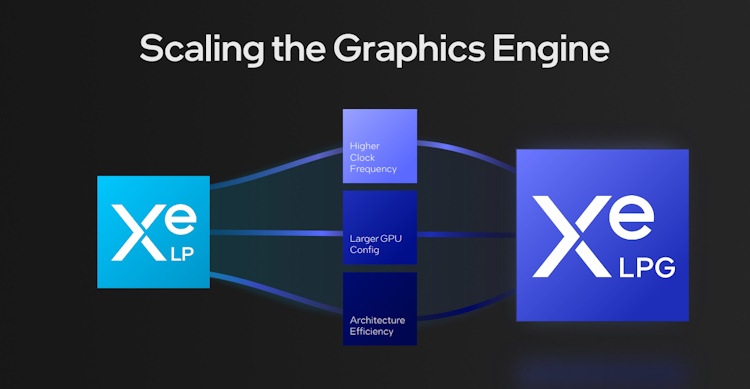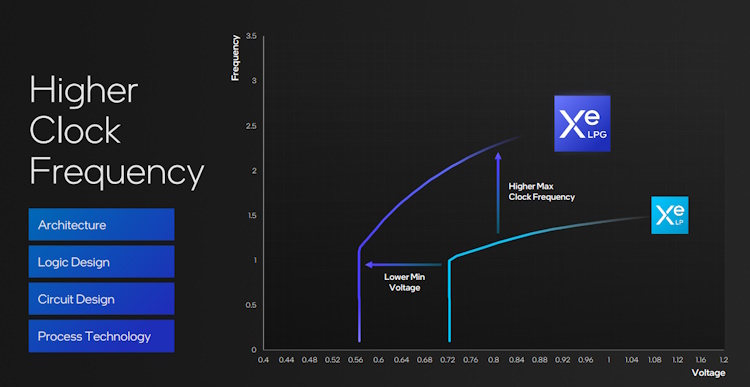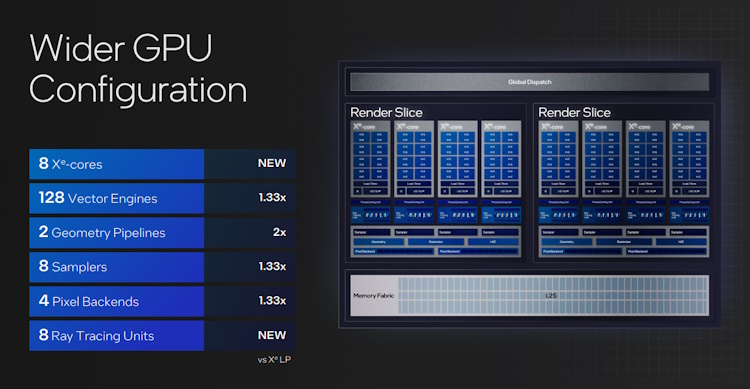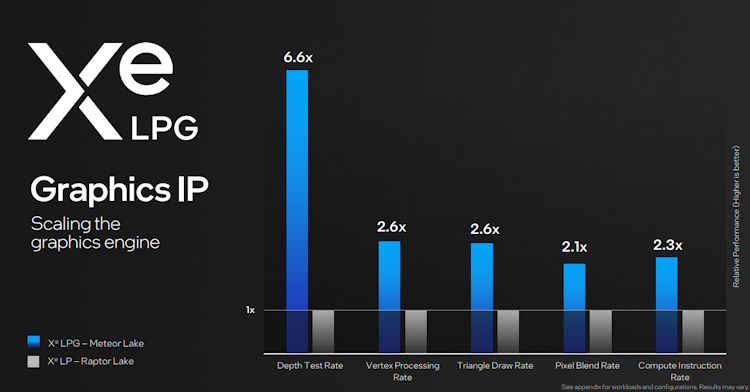
After months of waiting and speculation, Intel finally announced its 14th Gen Meteor Lake architecture. With a plethora of improvements, including better power efficiency, AI at scale, and new E- and P-core microarchitecture, the chipset family has a few upgrades up its sleeve. However, one of the most prominent advancements came from graphical power. Intel now brings its Arc GPU support to 14th Gen Meteor Lake chips through integrated graphics. Learn all about Intel Arc in the 14th gen below.
Ever since Intel Arc graphics came out, one of its biggest upsides was increased game frame rates. However, that was always restricted to a dedicated GPU format. That changes with Meteor Lake, as Intel Arc is now infused with integrated graphics to elevate gaming and other use cases. This, in turn, will provide dramatically improved frame rates.
New Intel Xe LPG Architecture with Hardware Ray Tracing
The vastly improved graphical performance has been made possible with the new Xe LPG architecture present on the disaggregated architecture. LPG is a combination of the company’s previous Xe LP iteration along with its HPG architecture. The new architecture also fulfills Intel’s goal of offering 2x the performance from the previous generation.
Furthermore, this has influenced the new Xe LPG architecture and given features never possible in chipsets. This includes support for DX 12 Ultimate, VRS, Hardware Ray Tracing, Sampler Feedback, and more. Intel claims that “everything you’ve come to expect from high-end graphics is now available in Meteor Lake Chips.” And yes, you read that right, Intel Integrated graphics will come with Hardware Ray Tracing (more on this below) for the first time.
Intel Xe LPG Uses Tri-Fold Approach
The new Intel Xe LPG engine that powers the magic behind Arc has been scaled to ensure it meets the company’s vision. This has been done through a tri-fold approach focusing on higher clock frequency, larger GPU configuration, and overall ‘architecture efficiency.

Intel’s 14th Gen Meteor Lake GPUs come with massive improvements in frequency. The new units can run faster at every voltage curve while using less energy for the same task.

The LPG architecture runs at higher clocks at any voltage and on lower voltage at any particular frequency. The company mentions that the lower voltage is important as it has allowed Intel Meteor Lake to deliver 2x perf/watt. Furthermore, this is also one of the first times the company has used machine learning for timing closure. This results in further power reduction.
Intel Is Using More Silicon Area to Power Arc
Inserting more power into a chip will naturally require more real estate. The company revealed it uses a wider GPU configuration by using more silicon area to power the graphics engine. To put it into numerical terms, the new 14th-Gen Meteor Lake GPU tile is 30% larger. Another new addition is the added 8 Xe cores, which are the computational blocks. The chip also comes with 128 Vector units compared to last year’s 96.

However, the show’s stars are definitely the new 8 Ray Tracing Units, which, as stated above, bring support for Hardware Ray-Tracing to Intel’s integrated graphics for the first time.
Intel has also focused on architectural efficiency. The Xe Core contains 16 256-bit vector engines. The core possesses 192KB of shared L1 Memory. It can be configured as a SLM (Shared local memory) or act as a cache altogether. Intel is using the same style configuration for Arc GPUs. This has been done for synergy and to bring a sense of software stability. Intel believes this will help software developers have a common platform, which will help the new integrated graphics.
Meteor Lake Bring DX 12 Ultimate & Ray Tracing Support
Besides the above computational improvements, one of the biggest announcements is the inclusion of DX 12 Ultimate and Ray Tracing in Intel’s 14th Gen Meteor Lake. The support for native DX 12 will bring features like hardware Ray-Tracing, mesh shading, VRS Tier 2, and sampler feedback.

While Intel did not share any exact metrics, it did share some architectural tests testing the new Xe LPG against LP in a few tests. As you can see yourself, the new Xe LPG scores almost 7x higher in the Depth test. The same pattern is repeated in Vertex Processing, Triange Draw Rate, and more.
Intel showcased the same at its Intel Tech Tour Malaysia 2023 behind closed doors, where the company showed a gameplay video of Forza Horizon 4 running at a smooth 50-60 FPS through the onboard Intel Arc graphics. While the game setting and machine configurations were not revealed, the demo looked extremely smooth with no stutters. This performance should carry over to other popular games as the chips slowly roll out.
Ray Tracing Comes with More Use Cases Besides Gaming
Ray Tracing, on the other hand, finally makes its entry into Intel’s Meteor Lake. The company confirmed the same when talking about HW RT use cases. The company showcased UL’s new Solar Bay benchmark, showing that the new integrated graphics can do ray tracing in real time. Combined with the breadth of improvements above, this indicates Meteor Lake successfully using HW RT in future applications. However, that is not the only use case of Intel’s new LPG.

Creators also get a massive boost as you can now run Blender on Intel’s 14th Gen Meteor Lake chips. This is partly due to Intel’s role in Embree, its RT library, which has hardware ray tracing support. Since Blender also uses Embree, users will now be able to run the software right from their chipsets. Intel showed off some hardware ray tracing Blender figures. As seen, the results show almost three times faster performance compared with traditional CPUs.
As its last use case, Intel also believes there are many more practical applications in Ray Tracing and is, hence, doing its own research into making that possible.
Intel Endurance Gaming Gives Optimal Gaming on Battery Life
While gaming on a laptop’s battery is the last thing you should do, Intel recognizes the need for portable gaming. As such, the integrated graphics on the new 14th Gen Meteor Lake will come with Intel’s new Intel Arc Control software. This will serve as the control panel that lets users adjust modes for Intel’s Endurance Mode, a new feature designed to manage power with graphics dynamically.
Users will be able to select from three different modes that will cap frame rates accordingly while providing a stable battery life. Intel showed the same as it presented stats wherein Rocket League ran with just 1W of power, which is amazing.
Besides the new graphical improvements, Intel also shed light on its disaggregated architecture, which includes the Xe Media Engine, which supports up to 8k @ 60 10-bit HDR decode. Intel also discussed the new Xe Display Engine, which has four pipes for multiple displays and wide support for HDMI 2.1, DP 2.1 20G, up to 8k @ 60 HDR, QHD, FHD, and more.
With hardware ray tracing coming to integrated graphics for the first time, Intel’s 14th-Gen Meteor Lake lineup will be amazing. Packed with 2x performance per watt and more power efficiency, the Arc inclusion will be exciting. Only time will tell what real-life performance we can expect from Intel’s Arc graphical platform.


















